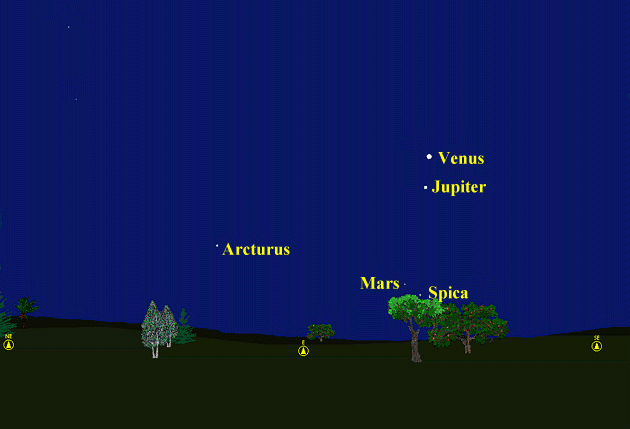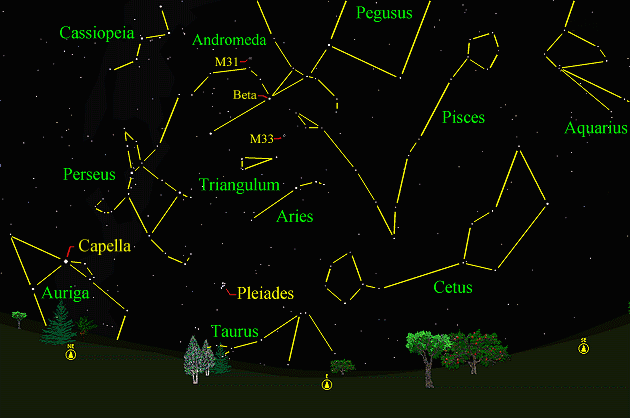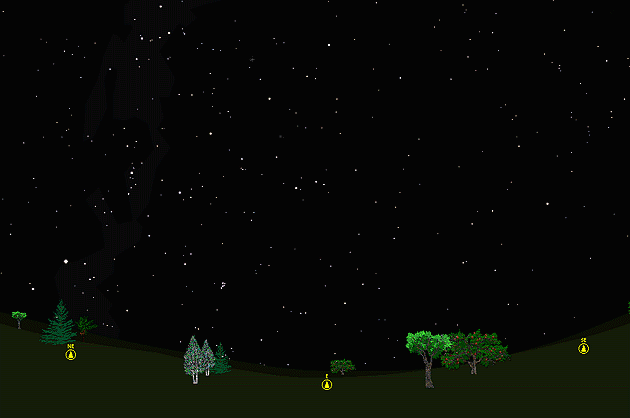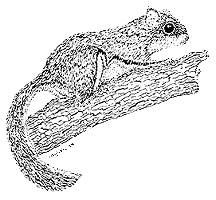The purpose of this feature is to give scout leaders,
educators and naturalists an idea of some of the natural events coming up each
month. We will try to cover a variety of natural events ranging from sky
events to calling periods of amphibians, bird and mammal watching
tips, prominent wildflowers and anything else that comes to mind. We will
also note prominent constellations appearing over the eastern horizon at
mid-evening each month for our area for those who would like to learn the
constellations. If you have suggestions for other types of natural
information you would like to see added to this calendar, let us know! Note: You can click on the hyperlinks to learn more about some of the featured items. To return to the Calendar, hit the "back" button on your browser, NOT the "back" button on the web page. Sky Events: Evening Sky: A total lunar eclipse occurs on the evening of October 27th. The earth first enters the umbra, or dark part of the earth's shadow, at 8:14pm CDT. Totality begins at 9:23pm CDT and ends at 10:45pm CDT. The earth leaves the umbra at 11:54pm CDT. These events are spectacular to observe, and we think the prettiest view is with either the naked eye or with binoculars. In the early evening hours, this is a good time of year to observe the rich star fields in the constellation Cygnus, the Swan. This constellation is directly overhead around 8:00pm CDT at mid-month. Dark skies make a huge difference here, and it's highly recommended that you get at least 30 miles out into the country away from city lights to get the best view. Pick an evening after the passage of a cold front for the clearest skies. Bring a lounge chair, a good pair of binoculars, a constellation book and red flashlight, and a blanket, then lay back and sweep slowly over the constellation. Near the bright star Deneb, see if you can spot the brighter parts of the North American Nebula. About 3,300 light-years away, its name was coined by German astronomer Max Wolf in 1890. If you have a rich-field telescope, you may want to see if you can spot the fainter "Pelican Nebula" just off the "east coast" of North America. You can see it faintly in the photograph between two brighter stars. Any nebulosity you see will be either colorless or faintly greenish. It will not have the red color it does in the photos, as the human eye is not very sensitive to this wavelength at low light levels. The rift that you see in the Milky Way here is caused by dark clouds of nebulosity that hide the stars beyond them. Albireo is a beautiful double star in small telescopes. Its two component stars are blue and orange. Both stars and their colors can be seen with 10x image-stabilized binoculars. The photograph below was taken near Monteagle, Tennessee, in the south Cumberland Mountains. The bright star at the right of the frame is Vega. For a very good and detailed observing guide to this area of Cygnus, see "Navigating North America," by Sue French in the October issue of "Sky and Telescope."
Morning Sky: Saturn rises just after midnight at midmonth in Gemini, near the bright stars Castor and Pollux. Venus rises about 3:30am on October 3rd, when it appears less than 1/4 of a degree away from the bright star Regulus, in Leo. Jupiter rises about 5:30 at midmonth, and you can look for it about 20 degrees (two fists at arm's length) below Venus. Mars appears in the morning sky towards the end of the month, but may require binoculars to see. The image below shows the view on the morning of October 31st. Use Venus and Jupiter to find Spica in binoculars, then look about 2 degrees up and to the left of Spica for Mars, which will be fainter. The image below is for 5:35am CST (not CDT!) on the 31st.
The Orionid meteor shower peaks on the morning of October 21st. The time to observe is in the early morning hours. Look southeast towards Orion. Although the expected number of meteors per hour is only around a dozen, this shower has a reputation for producing bright meteors with persistent trains. This shower occurs when earth runs into the debris trail from comet Halley, whose last appearance in 1985 was resulted in the manufacture of some very dubious quality telescopes.
All times noted in the Sky Events are for Franklin, Tennessee and are Central Daylight Time. These times should be pretty close anywhere in the mid-state area. Constellations: The views below show the sky looking east at 9:00pm CDT on October 15th. The first view shows the sky with the constellation outlined and names depicted. Star and planet names are in yellow. Constellation names are in green. The second view shows the same scene without labels. Prominent are Cassiopeia, Queen Cassiopeia, Andromeda, Princess Andromeda, Perseus, Triangulum, the Triangle, Aries, the Ram, and Cetus, the Sea Monster. Look above beta Andromedae and see if you can pick out the faint glow of the M31, The Andromeda Galaxy, over 2 million light years away! City dwellers may need binoculars to pick it out. Simon Marius, in 1610, compared its soft glow to "the light of a candle shining through horn." To get the best view, wait until the square is high overhead to look. If you find the Andromeda Galaxy, you might want to try to see M33, another nearby galaxy in Triangulum. Auriga, the Charioteer, with its bright star Capella, and Taurus, the Bull, are rising in the northeast. Look for the Pleiades, a beautiful open star cluster, not far above the eastern horizon. Also known as the "Seven Sisters," this cluster has been known since antiquity.
On Learning the Constellations: We advise learning a few constellations each month, and then following them through the seasons. Once you associate a particular constellation coming over the eastern horizon at a certain time of year, you may start thinking about it like an old friend, looking forward to its arrival each season. The stars in the evening scene above, for instance, will always be in the same place relative to the horizon at the same time and date each October. Of course, the planets do move slowly through the constellations, but with practice you will learn to identify them from their appearance. In particular, learn the brightest stars for they will guide you to the fainter stars. Once you can locate the more prominent constellations, you can "branch out" to other constellations around them. It may take you a little while to get a sense of scale, to translate what you see on the computer screen or what you see on the page of a book to what you see in the sky. Look for patterns, like the stars that make up Cassiopeia. The earth's rotation causes the constellations to
appear to move across the sky just as the sun and the moon appear to do.
If you go outside earlier than the time shown on the charts, the constellations
will be lower to the eastern horizon. If you observe later, they will
have climbed higher. As each season progresses, the earth's motion around the sun causes the constellations to appear a little farther towards the west each night for any given time of night. The westward motion of the constellations is equivalent to two hours per month. A good book to learn the constellations is H. A. Rey's
classic, The Stars, A New Way to See Them. Rey's depictions of the
constellations and witty commentary are terrific. A good general reference book on astronomy is the Peterson
Field Guide, A Field Guide to the Stars and Planets, by Pasachoff.
The book retails for around $14.00. A good beginners software program for learning the night sky
is the Starry Night Beginner program. Visit the Starry Night web site at
www.starrynight.com The program retails for around $30.00 and
contains a wealth of information. Amphibians:
The frog and toad choruses continue to diminish in October, but some frogs and toads are still calling. Another name for the Spring Peeper is the "Autumn Piper", and these small frogs can be heard calling from patches of woods in the fall. On cool October nights, Southern Leopard Frogs sometimes call and breed as the cooler temperatures mirror their early spring breeding period. Upland Chorus Frogs sometimes give a very dry, raspy version of their call in October. You can locate many of the frogs and toads that have been calling more frequently earlier in the year by driving the back roads slowly on rainy nights. This is a two person job. One person watches the road for amphibians and one person looks out for other vehicles. Anything over about 15mph is "speeding".
Birds: Fall migration continues. Try to get out and bird as often as you can. Recommended: Bird Finding in Tennessee, Michael Lee Bierly. A classic guide to finding birds in Tennessee. The Sibley Guide to Birds, David Allen Sibley The Sibley Guide to Birds of Eastern North America, David Allen Sibley This new Sibley Guide covers only eastern North America, is quite compact, and is less expensive than the larger Sibley. An inexpensive guide for beginners is the Golden Guide for Birds.
Flying Squirrels:
This time of year flying squirrels at our farm become quite active in nut-bearing hickories at night. Listen for their high-pitched metallic notes. To me the sound is similar to the sound that steel rails make (the "singing" ) as a train approaches. If you have blue bird boxes on your property, you might check them to see if a flying squirrel resides there during the daylight hours.
Archives (Remember to use the back button on your browser, NOT the
back button on the web page!)
Natural Calendar
September 2004
Natural Calendar
February 2004
Natural Calendar
December 2003
Natural Calendar
November 2003
Natural Calendar
September 2003
Natural Calendar
February 2003
Natural Calendar
December 2002
Natural Calendar
November 2002
Nature Notes Archives:
Nature Notes was a page we published in 2001 and 2002 containing our
observations about everything from the northern lights display of November 2001
to frog and salamander egg masses. Night scenes prepared with Starry Night Pro software All photographs Ó2004 LEAPS
|






